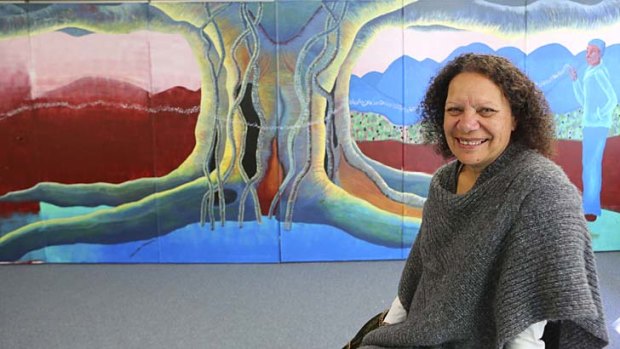By Barbara Drury
A class of year 7 students grappling with a new language is not an uncommon sight in Australian high schools. But the challenge faced by students at Woolgoolga High School is unique. They are learning Gumbaynggirr, a traditional Aboriginal language.
School principal Guy Wright believes his is the only school in the state, perhaps in Australia, that has introduced an Aboriginal language across the entire year 7 cohort. With 182 students in six classes, it was a major undertaking involving input from parents, teachers and the local Aboriginal community.

Elder and artist: Aunty Shaa began recording and writing down Gumbaynggirr in the 1980s.Credit: Frank Redward
A mural in the classroom painted by a community elder, Aunty Shaa, explains the significance of what the school is doing. It depicts an ancient warrior standing by the Tree of Knowledge, handing down his language to the present inhabitants of the land.
"The ancestors want to share our dreaming and culture with you because we are custodians of this land and it's our responsibility to do that. The tree can help you open up Gumbaynggirr culture,'' Aunty Shaa explains to the class.
The name Woolgoolga comes from the word ''wiigulga'', meaning black apple tree. The comprehensive public high school is built on traditional Gumbaynggirr land, which extends from Nambucca in the south to Grafton on the mid-north coast.
Of the school's 900-plus students, 9 per cent identify as Aboriginal. A further 7 per cent are Sikh and a number of students are refugees from Ethiopia, the Republic of Congo, Kenya and Sudan.
NSW high schools are required to teach a language other than English in years 7 and 8. While Woolgoolga has previously offered French and Japanese, Mr Wright says the languages failed to engage all the students. So he decided to take an approach that was more relevant to the students, with positive spin-offs for the school and the community.
The first step was recruiting a passionate teacher, Larry Hancock, who originally trained as a Japanese teacher.
"I started Gumbaynggirr lessons for indigenous kids three years ago but they had no one to speak to,'' Mr Hancock said. ''Now you hear the language in the playground and it brings the Aboriginal community into the classroom. The kids see that and it's making a cultural change in the school.''
Mr Hancock, who is not Aboriginal, also runs a weekly after-school class for interested parents, teachers and community members. He learnt Gumbaynggirr at the Muurrbay Aboriginal Language and Culture Co-operative in Nambucca, where Aunty Shaa was part of a team that started recording and writing down the rapidly disappearing language in the 1980s.
Local elder Uncle Bing is believed to be the last person in the community who grew up speaking Gumbaynggirr as his first language. He was recently invited to the school to sit in on a class and he told Mr Wright he had not thought he would have the opportunity to have another conversation in his own language.
Aboriginal education assistant Jo Hine has already noticed a difference in the confidence of Aboriginal students at the school.
"They are more likely to speak up in class,'' she said. ''They feel that the whole community is passionate about their language.''
When the current group of year 7 students reach year 9, the school plans to offer Gumbaynggirr alongside French and Japanese. Some students began learning Gumbaynggirr at primary school and more local schools are expected to join the program. Southern Cross University's Coffs Harbour campus also offers a course in Gumbaynggirr and there are about 20 tutors offering classes in local schools.
Mr Hancock's hope is that some of his current students will go on to study the language at university and return to teach it in local schools, completing the circle.
"With quality teaching, the kids are feeling engaged in something that has meaning for them,'' he said. ''It's made for a more harmonious school.''
And it seems to be working.
"It feels relevant to where we live,'' student Pavan Mullee said.
Indigenous student Sam Gustafson agrees: ''It's important to show we care about our language".
If proof is needed that Gumbaynggirr is a living language, indigenous student Tanisha Wallace says she and her friend Zoe use it when texting.